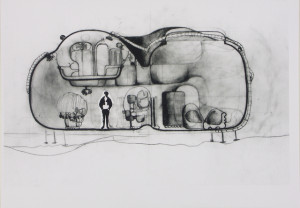Background Research
In a second step, I did a background research in certain topics of interest such as smart materials and their context in artistic projects, installations etc. Comments have been written on most pages on the right side as to analyse the explained content so as to judge whether they could have any significance in my context.
background research
Future Scenarios
Often, these installations have understandably a futuristic vision. If we take the futuristic idea further, there are books which deal with smart buildings or houses. I find two book relevant in this topic which helped me in focusing my context research.
The Melding Plague
In Alaistair Reynold’s Revelation Space Universe. The Melding Plague is a nanotech virus that attacks anything that has nanotechnology present within it and does not discriminate between human and machine. It attempts to meld the nanomachines and implants that are commonly present in the bodies of humans, with the structure of their body on a cellular level. This results in horrific, uncontrollable modifications to the body of whoever is infected and almost inevitably leads to death. By the time that the worst of the Plague had passed, the city was almost unrecognisable, its buildings were twisted and deformed and the population decimated by the Plague.
Psychotropic Houses
The short story The Thousand Dreams of Stellavista in the book Vermilion Sands written by James Graham Ballard introduces very peculiar type of houses that Ballard entitled Psychotropic (ethymologically: that is stimulated by the mind). Those houses physically reacts to their inhabitant’s mood and stress and thus adapt their spatiality to them.
It’s always interesting to watch a psychotropic house try to adjust itself to strangers, particularly those at all guarded or suspicious. The responses vary, a blend of past reactions to negative emotions, the hostility of the previous tennants…
Then suddenly the room grew calm. A second later, just as I had raised myself on one elbow, a violent spasm shook it, twisting the walls and raising the bed off the floor. The whole house began to tremble and twist. Caught at the centre of this epileptic seizure, the bedroom alternately contracted and expanded like the ventricles of a dying heart.

James Graham’s depiction of a psychotropic house
The dystopian views of smart houses opens up interesting questions. Different kinds of aspects were introduced of what it could feel like if a building were looking at us in its own „eyes“. With smart materials, sensors and such, buildings could feel us in some way. With neural-like networks, they could remember, learn and anticipate our moves, watching and observing us as we work or play in its innards. If we start thinking forward in time, in a future scenario, we could start saying that a building would heal itself instead of repair. What would happen if it were sick and catch a virus of some sort. How would this disease manifest itself? Perhaps we would start seeing ulcers or growth proliferations of some kind in certain corners of the building until it cures. How would it express itself if people would shout at it.
 James Graham’s depiction of a psychotropic house
The dystopian views of smart houses opens up interesting questions. Different kinds of aspects were introduced of what it could feel like if a building were looking at us in its own „eyes“. With smart materials, sensors and such, buildings could feel us in some way. With neural-like networks, they could remember, learn and anticipate our moves, watching and observing us as we work or play in its innards. If we start thinking forward in time, in a future scenario, we could start saying that a building would heal itself instead of repair. What would happen if it were sick and catch a virus of some sort. How would this disease manifest itself? Perhaps we would start seeing ulcers or growth proliferations of some kind in certain corners of the building until it cures. How would it express itself if people would shout at it.
James Graham’s depiction of a psychotropic house
The dystopian views of smart houses opens up interesting questions. Different kinds of aspects were introduced of what it could feel like if a building were looking at us in its own „eyes“. With smart materials, sensors and such, buildings could feel us in some way. With neural-like networks, they could remember, learn and anticipate our moves, watching and observing us as we work or play in its innards. If we start thinking forward in time, in a future scenario, we could start saying that a building would heal itself instead of repair. What would happen if it were sick and catch a virus of some sort. How would this disease manifest itself? Perhaps we would start seeing ulcers or growth proliferations of some kind in certain corners of the building until it cures. How would it express itself if people would shout at it.